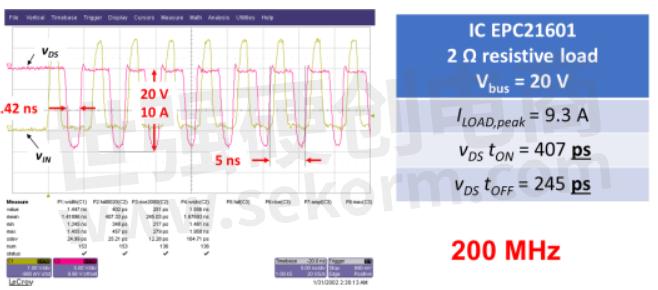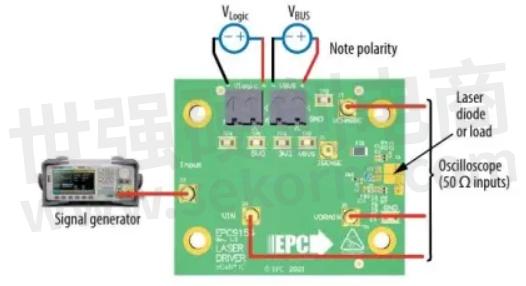LiDAR System Design of ToF Laser Driver with GaN Can Reach High Distances

The new gallium nitride (GaN) family aims to deliver time-of-flight (ToF) applications for autonomous cars and 3D sensing across the consumer and industrial sectors. In an interview with EE Times, Alex Lidow, CEO at EPC, highlighted how introducing the eToF laser driver family's for LiDAR system design at a low cost competes with the Mosfet when it comes to LiDAR applications. The EPC21601 laser driver integrates a 40V, 10A FET with an integrated gate driver and 3.3 logic level input into a single chip.
LiDAR is a technique for measuring the distance between objects using pulsed lasers, and through the acquired information, a 3D image can be obtained. LiDAR technology offers accuracy, wide-area coverage, and full digital support for data collection.
FETs with GaN technology prove suitable as a driver element for laser switching, driving high-current and extremely short pulses. Short pulse widths provide higher resolution, and a high pulse current enables LiDAR systems to reach high distances.“GaN technology supports these two characteristics making it ideal for LiDAR,”commented Lidow.
Time of Flight (ToF) for LiDAR
Pulsed LiDAR technology is used for long distances with direct measurement of how long a photon has traveled the round trip distance, and this is called Time of Flight (ToF).“The ToF technology is pretty simple, it essentially measures the round trip time,“said Lidow.
When you have to get close to an object in these applications, there is an issue with the laser signal's pulse width.“Light travels one meter every three nanoseconds, so if you have a pulse that’s one nanosecond wide, you can't really measure objects that are closer than about one meter, unless what you’re looking at is the phase difference between the output and the input. So, basically, you look at the output pulse, and you subtract that from the return pulse. And so what people do for this indirect time-of-flight to measure short distances is to use a lot of light power. And they do that with a pulse stream on the order of 100 megahertz. And they measure the phase difference of that integrated pulse stream, which tells you how far away the object is,”said Lidow.
He added,“If you're looking at something a few feet away, you only need about 1 to 10amps of current, employing vertical-cavity surface-emitting lasers (VCSELs). And if you want to go farther away, the power requirements get bigger because you're using a non-directional optical pulse. So indirect time-of-flight tends to be an excellent mechanism for doing near applications, and it's not an effective mechanism for distant objects.”

Figure 1: Pulse Width and Amplitude
eToF for LiDAR
The EPC21601 is a laser driver that is controlled using 3.3V logic at high frequencies up to 200MHz to modulate laser drive currents up to 10A. The on and off times are 410ps and 320ps, respectively. The EPC21601 is a single-chip plus eGaN® FET driver using EPC's proprietary GaN IC technology in a chip-scale BGA form factor that measures 1.5mm x 1.0mm.
It is a 40-volt, 10-amp FET device intended to drive a VCSEL with a 3.3-volt logic-level input.“One of the things to consider when using two separate chips instead of one is that two chips will have about 50 Pico Henry of inductance between the driver and the power FET. And if you have 50Pico Henry of inductance, your speed is halved. And so, even if you go down to 10 or 20Pico Henry, it's a big deal. The integration of the driver and power FET reduces the common source inductance to just a few Pico Henry, thus improving pulse rise and fall times, and therefore resolution for objects that are very close,”said Lidow.
The EPC21601 is offered in a chip-scale package (CSP) and is easier to assemble, saves PCB space, and increases overall efficiency.“This product family will enable faster adoption of ToF in a wider range of end-user applications,”said Lidow. He added,“Ultrasonic sensors cannot detect less than 30 centimeters. That's their limitation, which has to do with operating frequency. So you can replace both ultrasonic sensors and camera chips with a single short-range.”The EPC21601 is specifically designed for high speed, short pulse operation while minimizing the number of external parts required.

Figure 2: Timing Performance of EPC21601

Figure 3: Timing Performance of EPC21601 – 200MHz

Figure 4: Demo Boards

Figure 5: Block diagram of EPC9154 development board
Through Figures 2 and 3, Lidow showed how a series of tests confirmed the new device's validity for high-speed applications.“In Figure 2 there's a 10-amp pulse train, 20volts high, nine nanoseconds wide, and the on-time is about 400 picoseconds, the off-time is about 300 picoseconds. And that on and off time is limited by the inductance. Very short distances can be resolved in this case. Figure 3 shows a pulse train of 200 megahertz. So, in this case, we have a 1.4 nanosecond wide pulse, with still 10amps and 20volts. From the figure, you can see that the turn-off time here is 245 picoseconds times 300 picoseconds,”said Lidow. He added that the new IC, according to pictures 2 and 3, can handle very fast operation with any laser technology used in ToF applications.
Lidow said there are also development boards such as the EPC9154, which features the EPC21601 eToF laser driver IC and is intended primarily for driving short-pulse high-current laser diodes. Capabilities include minimum pulse widths of < 2ns, peak currents > 10A, and a bus voltage of 30V (Figures 4-6). The EPC9154 is capable of driving laser diodes with current pulses can result in peak powers of several tens of watts of optical power. Laser diodes for lidar applications are designed with this in mind, but thermal limitations of the laser package mean that pulse widths, duty cycles, and pulse repetition frequency limitations must be observed.

Figure 6: Connection and measurement setup
Switching losses that might compromise performance actually do not contribute significantly to the thermal problem for a specific reason, as Lidow pointed out, because the laser is used in burst mode.“So it periodically emits a 200-megahertz pulse stream, maybe at 100 kilohertz or 10 kilohertz, depending on the frame rate you want to achieve. And in every single case, the laser is the thermal limit,”said Lidow.
He added,“As a competitor, I see MOSFETs. The silicon MOSFET is very low cost, and people are very familiar with it. But the advent of high frequencies and power density will be limited in applications. For example, in motor drives, we’re now seeing a big increase in GaN because motors are going from 20 kilohertz to 100 kilohertz for a low voltage. With the new generation of cars, they need four or five kilowatts, and at four kilowatts with the best MOSFET, you need a seven-phase buck converter with a MOSFET. GaN can do it in four stages, saving space and increasing efficiency.”
The consumer sector will benefit greatly from this new eToF, both luxury robots and other less expensive ones. All are incorporating LIDAR to make sure they don't hit something wrong or know exactly where they are to detect location. Drones will see the use of these solutions increasing their market for ground recognition applications.
- +1 Like
- Add to Favorites
Recommend
- EPC Revolutionizes Lidar System Design with Release of EPC21601 eToF Laser Driver IC
- EPC21601 eToF Laser Driver IC Wins ASPENCORE’s World Electronics Achievement Award – Product of the Year 2021 Power Semiconductor / Driver IC
- EPC‘s ePower Stage EPC2152 Integrated Circuit Named Finalist in Prestigious Elektra Awards
- EPC2152 ePower™ Stage – Redefining Power Conversion
- EPC2152 Receives Elektra Award 2020 for Semiconductor Product of the Year (Analogue) for ePower Stage IC
- EPC2152 GaN Integrated Power Stage – Redefining Power Conversion
- Sharge Selects GaN FETs EPC2218 from EPC for High-power USB PD Charger Retro 67 to Achieve the Most Efficient Power Conversion
- Pulsing 1550nm Lasers for Lidar Driven by EPC‘s eGaN® FET Technology
This document is provided by Sekorm Platform for VIP exclusive service. The copyright is owned by Sekorm. Without authorization, any medias, websites or individual are not allowed to reprint. When authorizing the reprint, the link of www.sekorm.com must be indicated.





























































































































































































































































































































































































































































































































































































































































































































































































































































































